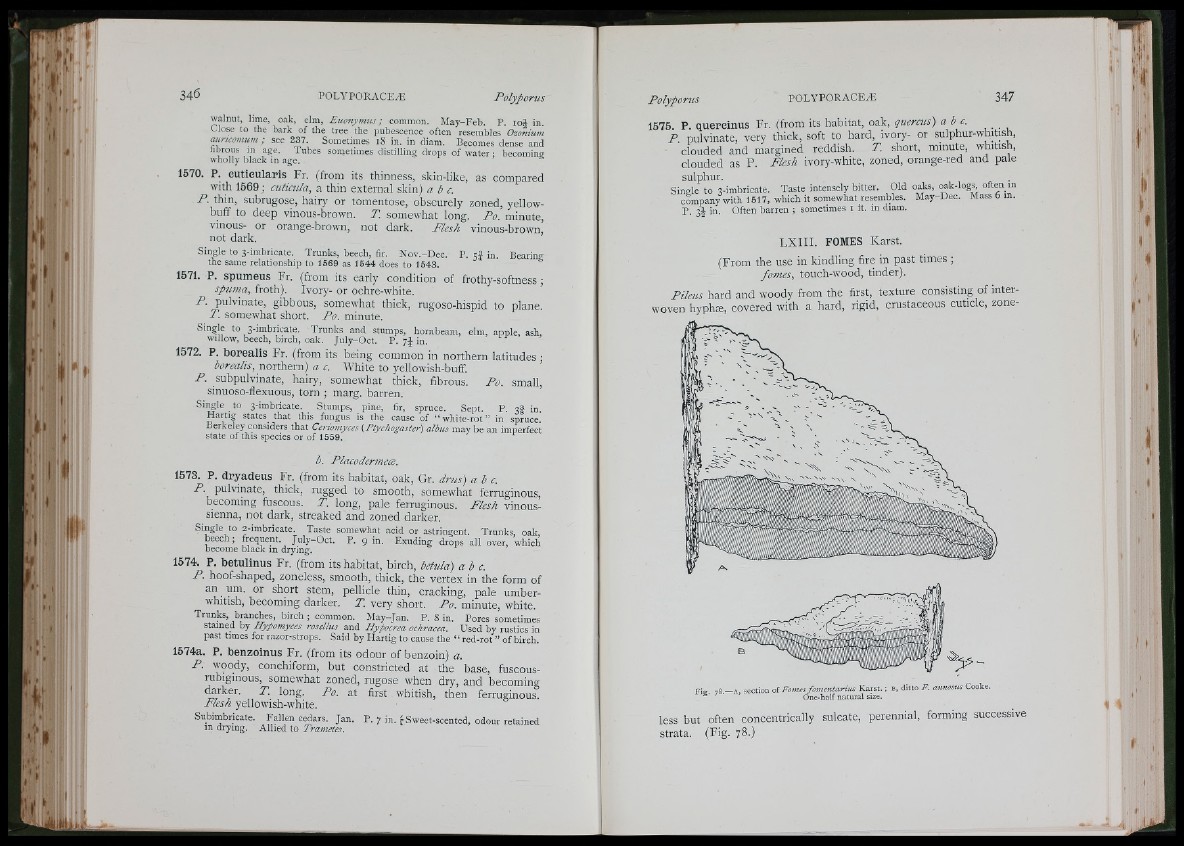
I!’
walnut, hme, oak, elm, Enonymns; common. May-Feb. P. lo j in.
Close to the bark of the tree the pubescence often resembles Ozonium
mmcomum ; see 237. Sometimes 18 in. in diam. Becomes dense and
hbrous in age. Tubes sometimes distilling drops of water ; becoming
wholly black m age. ^
1570. P. eutieiilaris Fr. (from its thinness, skin-like, as compared
with 1569; cuticula, a thin external skin) abc.
P. thin, subrugose, hairy or tomentose, obscurely zoned, yellow-
buff to deep vinous-brown. T. somewhat long. Po. minute,
vinous- or orange-brown, not dark. Flesh vinous-brown,
not dark.
Single to 3-imbricate. Trunks, beech, fir. Nov.-Dee. P. cf in Bearing
the same relationship to 1669 as 1544 does to 1543.
1571. P. spumeus Fr. (from its early condition of frothy-softness;
spuma, froth). Ivory- or ochre-white.
P . pulvinate, gibbous, somewhat thick, rugoso-hispid to plane.
T. somewhat short. Po. minute.
Single to 3-imbricate. Trunks and stumps, hornbeam, elm, apple, ash,
willow, beech, birch, oak. July-Oct, P. 7® in.
1572. P. borealis Fr. (from its being common in northern latitudes ;
borealis, northern) a c. White to yellowish-buff.
P. subpulvinate, hairy, somewhat thick, fibrous. Po. small,
sinuoso-flexuous, torn ; marg. barren.
Single to 3-iinbricate. Stumps, pine, fir, spruce. Sept. P. 3I in.
Hartig states that this fungus is the cause of “ white-rot ” in spruce.
Berkeley considers that Ceriomyces (Ptychogaster) albus may be an imperfect
state of this species or of 1559.
b. Placodermea.
1573. P. dryadeus Fr. (from its habitat, oak, Gr. drus) abc.
P. pulvinate, thick, rugged to smooth, somewhat ferruginous,
becoming fuscous. T. long, pale ferruginous. Flesh vinous-
sienna, not dark, streaked and zoned darker.
Single to 2-imbricate. Taste somewhat acid or astringent. Trunks, oak,
beech; frequent. July-Oct. P. 9 in. Exuding drops all over, which
become black in drying.
1574. P. betulinus Fr. (from its habitat, birch, betula) abc.
P. hoof-shaped, zoneless, smooth, thick, the vertex in the form of
an um. or short stem, pellicle thin, cracking, pale umber-
whitish, becoming darker. T. very short. Po. minute, white.
Trunks, branches, birch; common. May-Jan. P. 8 in. Pores sometimes
stained by Hypomyces rosellus and Hypocrea oehraeea. Used by rustics in
past times for razor-strops. Said by Hartig to cause the “ red-rot ” of birch.
1574a. P. henzoinus Fr. (from its odour of benzoin) a.
P. woody, conchiform, but constricted at the base, fuscous-
rubiginous, somewhat zoned, rugose when dry, and becoming
darker. T. long. Po. at first whitish, then ferruginous.
Flesh yellowish-white.
Subimbricate. Fallen cedars. Jan. P. 7 in. j Sweet-scented, odour retained
in drying. Allied to Trametes.
1575. P. queneinus Fr. (from its habitat, oak, quercus) abc.
P pulvinate, very thick, soft to hard, ivory- or sulphur-whitish,
clouded and margined reddish, T. short, minute, whitish,
clouded as P. Flesh ivory-white, zoned, orange-red and pale
sulphur.
Single to 3-imbricate. Taste intensely bitter. Old oaks, oak-logs^ often in
company with 1517, which it somewhat resembles. May-Dee. Mass 6 in.
P. 3® in. Often barren ; sometimes i ft. in diam.
LXIII. POMES Karst.
(From the use in kindling fire in past times ;
fames, touch-wood, tinder).
Pileus hard and woody from the first, texture consisting of interwoven
hyphæ, covered with a hard, rigid, crustaceous cuticle, zone-
F ia 78.—A, section o i Femes fom e n ia r iu s K a r s t.; B, ditto F . amwsus Cooke.
One-half n atural size.
less but often concentrically sulcate, perennial, forming successive
strata. (Fig. 78.)